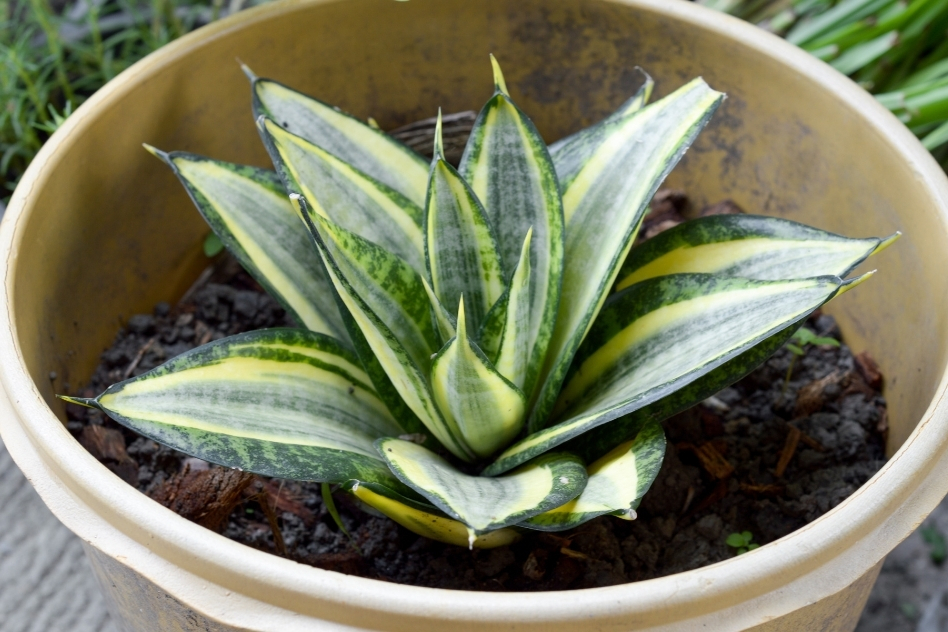Some plants are easier to take care of than others and one of those is Sansevieria Masoning (Whale Fin Snake Plant). This beautiful plant is best known for its conspicuous leaves and tender presence.
One of the most notable things about the Sansevieria is that it grows rather slowly so you’ll need to be patient and loving. However, it’s also one of the easiest indoor plants to own.
They can be left for several days without being watered so they are perfect for people who happen to travel a lot.
This plant also serves as a natural air purifier, making it an amazing choice for any household. With that said, let’s dive deeper into the care and maintenance of this wonderful plant.
Sansevieria Watering Guide
Since you won’t be watering this plant as often as you would other house plants, you’ll have to be diligent in getting it right. This plant actually needs to dry out a bit between watering sessions. It is possible to overwater it.
The first tip when watering the Sansevieria is to make sure that you thoroughly soak the soil. Water will seep through the drainage hole so discard it. Do not allow water to remain in the drainage area because your plant will be at risk of root rot if it sits in water.
Your first option is to take the plant to the sink. This is the easiest way to water your Sansevieria but not always the most practical. If using the sink, just let the water run until it seeps from the drainage, allow it to fully drain, and then take the plant back to its rightful spot.
If it’s too inconvenient to carry the Sansevieria to the sink, then use a pitcher to slowly apply water to the soil. Make absolutely sure that any water that seeps from the drainage area is removed from the collector.
If you leave water in the collection area, it can cause your plant’s root to rot. It also invites mold.
For the Whale Fin, it’s important that you allow the soil to completely dry out before watering it again. Water it the same day as the soil dries out.
Use your finger to check the soil every day so that you know when it needs water.
If you don’t want to get your hands dirty, then you can use the weight of the pot to determine when it needs watering. The pot will be lighter if the soil is dry.
Soil and Potting Guide
Sansevieria plants love soil that drains easily and quickly. Cactus potting soil is the best choice but you should also mix in some pumice so that it drains more sharply. The ratio is approximately two parts cactus potting and one part pumice.
What this mixture does is allowing the water to drain through the soil rather than saturate it, leading to potential root rot.
With that in mind, make sure that the pot has a drainage hole so that the soil doesn’t get saturated.
Finally, you must upgrade the pot every two years. Get a larger pot to allow the roots to expand further. Sansevieria plants have strong enough roots and will actually burst the pot if you don’t follow through with upgrading it.
Size: This plant can grow as small as 8 inches up to a whopping 7 feet depending on the environment.
Therefore, it’s recommended to start with a 4-inch pot and then move up 2 to 4 inches every time you change out pots to allow for growth.
Growth Rate: The Sansevierias has a very slow growth rate. As stated, you only need to upgrade its pot every two years.

Light Guide for the Whale Fin
The next part of the care guide will transition from water to light. With the Sansevieria, it’s important that the right lighting. Lighting is another reason this plant is so popular.
It can tolerate low light levels but its growth will just stagger. If given perfect lighting, this plant can reach as high as four feet tall – but you probably don’t want this. Fortunately, its growth is dependent on the environment.
With that in mind, the best light for the Sansevieria is indirect, bright lights. That means you need this plant close to a window. Even north windows where the sun will not directly hit the plant works, although the east or west windows are also great choices.
As long as it’s getting exposure to the sun, you should be fine. This plant is resilient!
If you live in a southern state, then the south windows are going to get your plant the most sun exposure. Therefore, you should filter it down a bit so that your plant isn’t getting too much sunlight.
Proper Fertilization Tips
Even though the Sansevieria is a light feeding plant, you’ll still want to provide some nutrients during the spring season. Fertilizers with low nitrogen are the best choice.
However, as I’ve said multiple times, the Sansevieria is quite resilient so if you happen to miss a few applications then it’s not the end of the world.
I recommend you use a fertilizer with every watering, but you can choose every other application if you want. What’s important is that you care for the plant and not miss the important stuff like lighting, watering, and soil.
Propagation Facts
Propagating the Sansevieria plant is an area that a lot of people get wrong. First of all, this plant takes a long time to grow so your patience will be tested. It takes quite a bit of time to propagate this household plant.
The best method of propagation is to allow the plant to grow pups and then plant those once they are large enough to sprout.

Proper Air Circulation Facts
Dry and stale air is fine for the Sansevierias but they are also good in humid environments, making them a great bathroom plant.
In short, you can place them in any room as long as it has access to a light source. As I’ve said several times, the Sansevierias is a versatile plant.
It can withstand a wide variety of temperatures. Just make sure you keep them away from air conditioning vents because the cold air can stunt them.
Even so, the Sansevierias can withstand outdoor temperatures as well so anything inside will be perfectly fine.
However, the Sansevierias doesn’t like frost so if you are keeping them outdoors, then be sure you bring them inside during snow or if the temperature drops below freezing.
Pest Control of Your Sansevieria
As long as you don’t oversaturate the roots with water, then you’ll find this plant to be highly resistant to pests. Avoid overwatering and you should be fine.
In the rare event that you do spot a pest, take action immediately because pests spread extremely quickly.
The Sansevieria Masoning (Whale Fin Snake Plant) is a great addition to your home and its resiliency makes it low maintenance.
All you need to do is to be aware of how much water you’re adding and make sure it drains properly. If you do that one thing, most other issues will be minor and you can enjoy fresh, enjoyable air inside of your home.






My whale fin sansiveria has sent up a number of pups, but they don’t have a wide base similar to what you typically see with this variety. Any idea why?